Organisational Behaviour Report: Culture, Motivation, and Performance
VerifiedAdded on 2022/12/27
|18
|5609
|95
Report
AI Summary
This report provides an analysis of organisational behaviour, focusing on how culture, politics, and power influence individual and team behaviour and performance within an organisation. It uses Sainsbury as a case study to illustrate these concepts. The report explores different cultural models, including Hofstede's cultural dimensions, and the impact of organisational power bases. It also examines content and process theories of motivation, such as McGregor's Theory X and Y, and their application in the workplace. The report further discusses the differences between effective and ineffective teams and explores various concepts of organisational behaviour, including the influence of leadership theories. The conclusion summarizes the key findings and emphasizes the importance of understanding organisational behaviour for achieving organisational objectives.
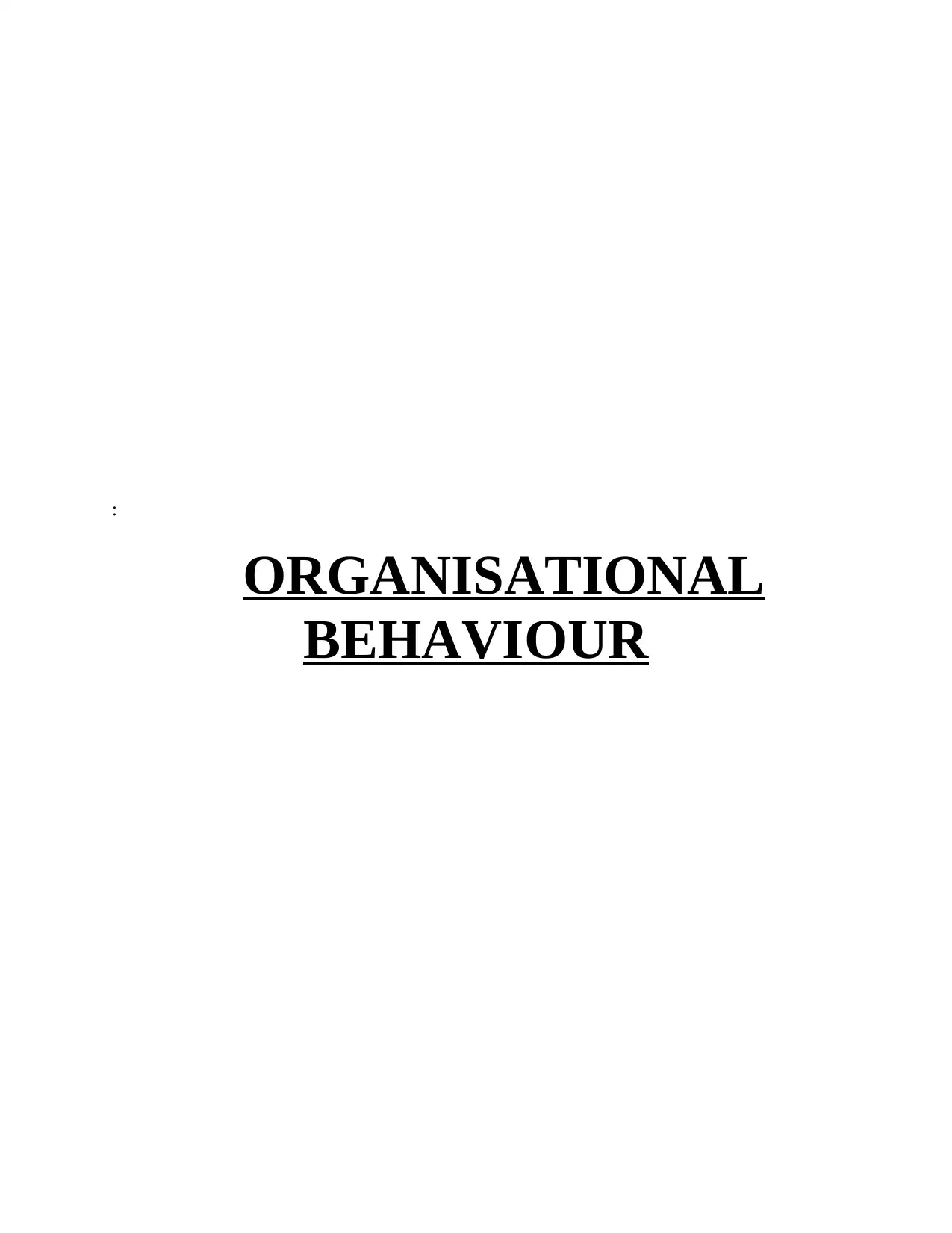
:
ORGANISATIONAL
BEHAVIOUR
ORGANISATIONAL
BEHAVIOUR
Paraphrase This Document
Need a fresh take? Get an instant paraphrase of this document with our AI Paraphraser
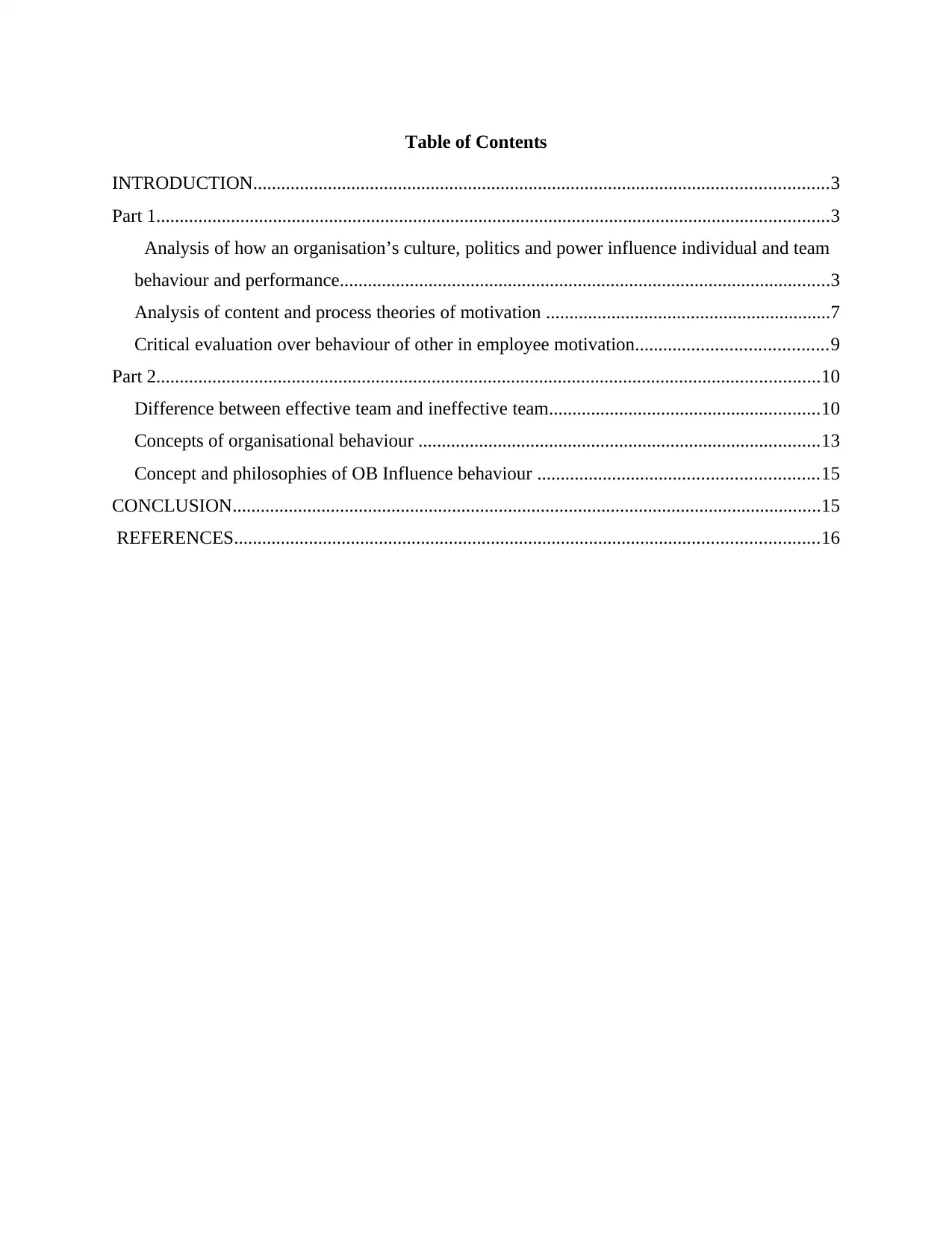
Table of Contents
INTRODUCTION...........................................................................................................................3
Part 1................................................................................................................................................3
Analysis of how an organisation’s culture, politics and power influence individual and team
behaviour and performance.........................................................................................................3
Analysis of content and process theories of motivation .............................................................7
Critical evaluation over behaviour of other in employee motivation.........................................9
Part 2..............................................................................................................................................10
Difference between effective team and ineffective team..........................................................10
Concepts of organisational behaviour ......................................................................................13
Concept and philosophies of OB Influence behaviour ............................................................15
CONCLUSION..............................................................................................................................15
REFERENCES.............................................................................................................................16
INTRODUCTION...........................................................................................................................3
Part 1................................................................................................................................................3
Analysis of how an organisation’s culture, politics and power influence individual and team
behaviour and performance.........................................................................................................3
Analysis of content and process theories of motivation .............................................................7
Critical evaluation over behaviour of other in employee motivation.........................................9
Part 2..............................................................................................................................................10
Difference between effective team and ineffective team..........................................................10
Concepts of organisational behaviour ......................................................................................13
Concept and philosophies of OB Influence behaviour ............................................................15
CONCLUSION..............................................................................................................................15
REFERENCES.............................................................................................................................16
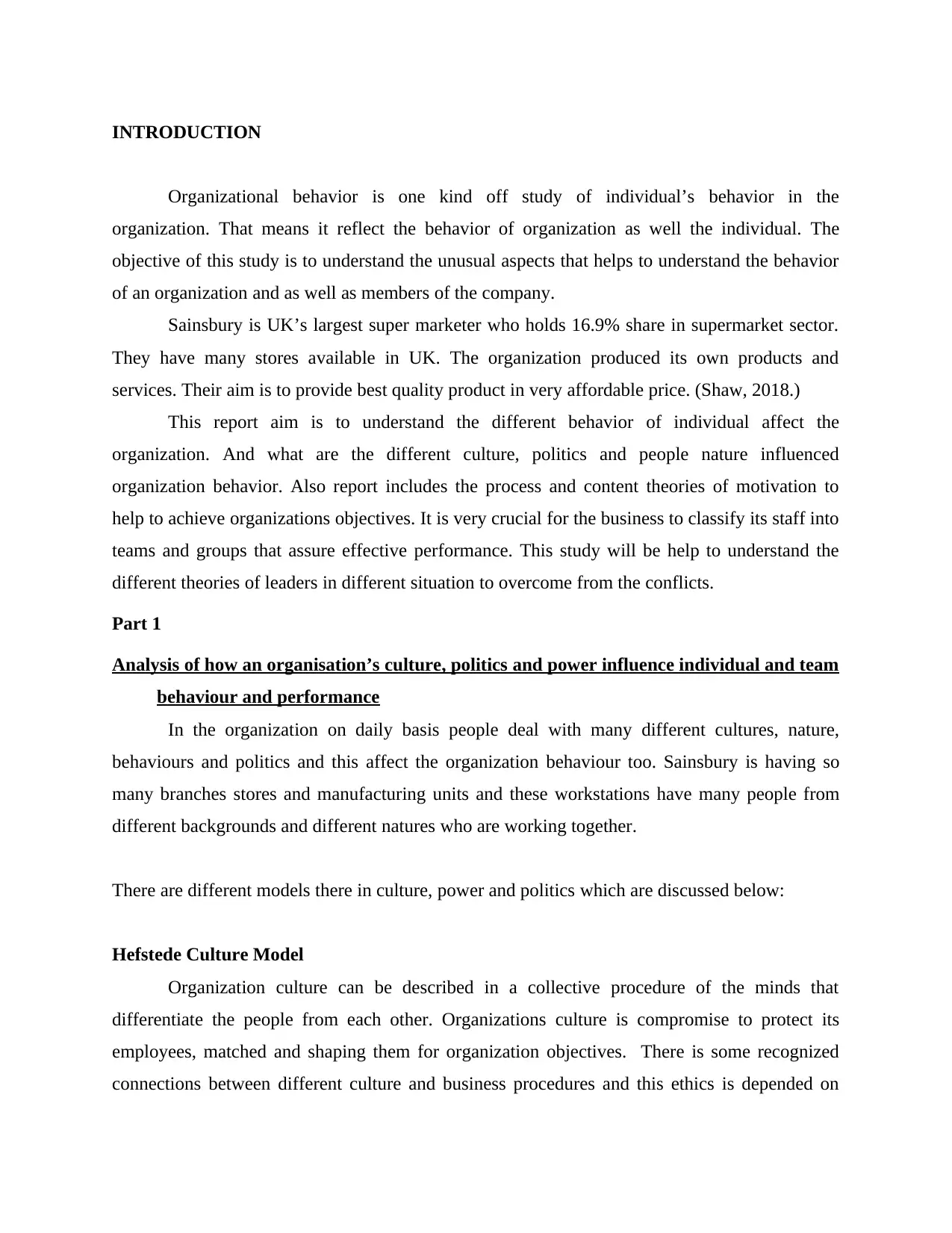
INTRODUCTION
Organizational behavior is one kind off study of individual’s behavior in the
organization. That means it reflect the behavior of organization as well the individual. The
objective of this study is to understand the unusual aspects that helps to understand the behavior
of an organization and as well as members of the company.
Sainsbury is UK’s largest super marketer who holds 16.9% share in supermarket sector.
They have many stores available in UK. The organization produced its own products and
services. Their aim is to provide best quality product in very affordable price. (Shaw, 2018.)
This report aim is to understand the different behavior of individual affect the
organization. And what are the different culture, politics and people nature influenced
organization behavior. Also report includes the process and content theories of motivation to
help to achieve organizations objectives. It is very crucial for the business to classify its staff into
teams and groups that assure effective performance. This study will be help to understand the
different theories of leaders in different situation to overcome from the conflicts.
Part 1
Analysis of how an organisation’s culture, politics and power influence individual and team
behaviour and performance
In the organization on daily basis people deal with many different cultures, nature,
behaviours and politics and this affect the organization behaviour too. Sainsbury is having so
many branches stores and manufacturing units and these workstations have many people from
different backgrounds and different natures who are working together.
There are different models there in culture, power and politics which are discussed below:
Hefstede Culture Model
Organization culture can be described in a collective procedure of the minds that
differentiate the people from each other. Organizations culture is compromise to protect its
employees, matched and shaping them for organization objectives. There is some recognized
connections between different culture and business procedures and this ethics is depended on
Organizational behavior is one kind off study of individual’s behavior in the
organization. That means it reflect the behavior of organization as well the individual. The
objective of this study is to understand the unusual aspects that helps to understand the behavior
of an organization and as well as members of the company.
Sainsbury is UK’s largest super marketer who holds 16.9% share in supermarket sector.
They have many stores available in UK. The organization produced its own products and
services. Their aim is to provide best quality product in very affordable price. (Shaw, 2018.)
This report aim is to understand the different behavior of individual affect the
organization. And what are the different culture, politics and people nature influenced
organization behavior. Also report includes the process and content theories of motivation to
help to achieve organizations objectives. It is very crucial for the business to classify its staff into
teams and groups that assure effective performance. This study will be help to understand the
different theories of leaders in different situation to overcome from the conflicts.
Part 1
Analysis of how an organisation’s culture, politics and power influence individual and team
behaviour and performance
In the organization on daily basis people deal with many different cultures, nature,
behaviours and politics and this affect the organization behaviour too. Sainsbury is having so
many branches stores and manufacturing units and these workstations have many people from
different backgrounds and different natures who are working together.
There are different models there in culture, power and politics which are discussed below:
Hefstede Culture Model
Organization culture can be described in a collective procedure of the minds that
differentiate the people from each other. Organizations culture is compromise to protect its
employees, matched and shaping them for organization objectives. There is some recognized
connections between different culture and business procedures and this ethics is depended on
⊘ This is a preview!⊘
Do you want full access?
Subscribe today to unlock all pages.

Trusted by 1+ million students worldwide
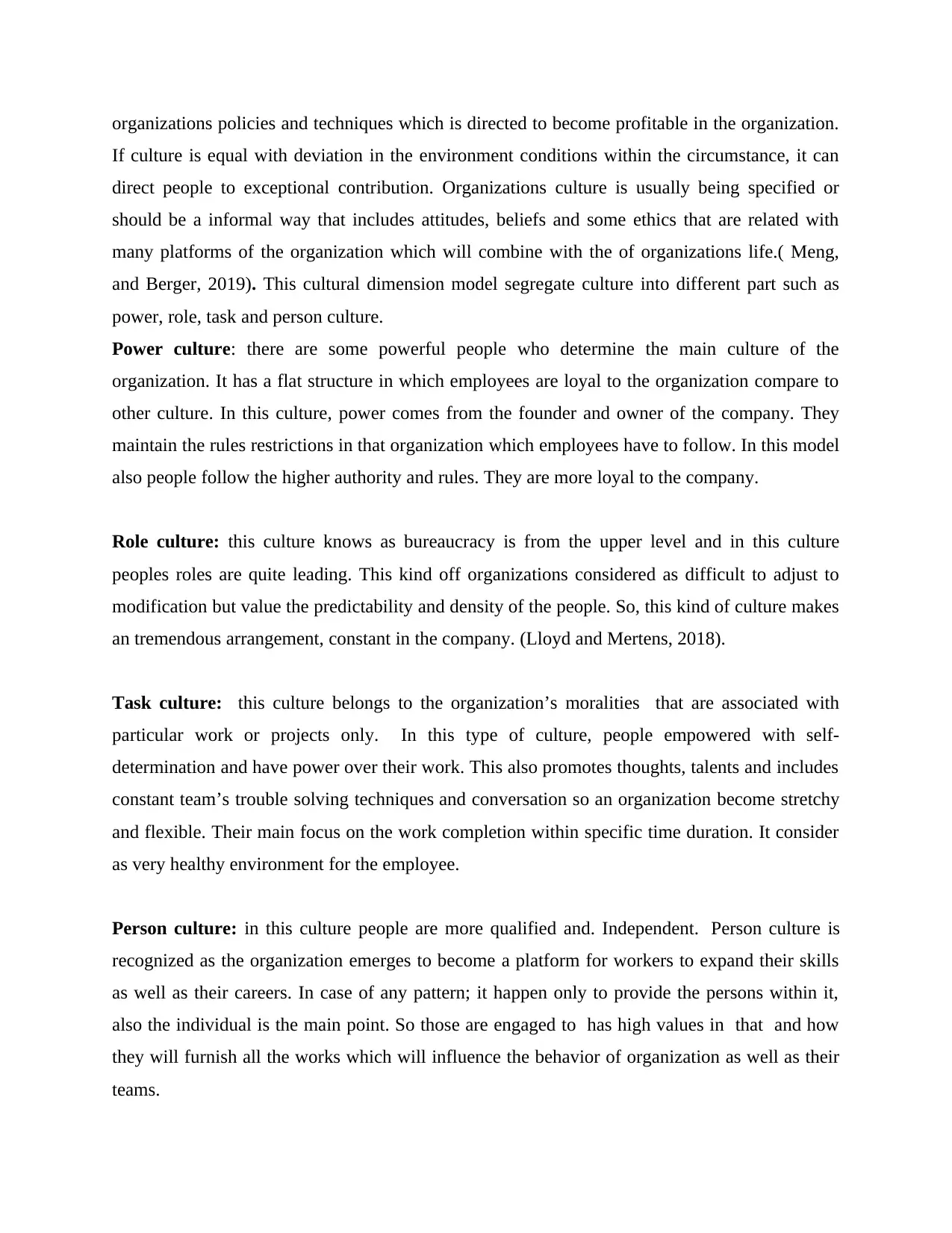
organizations policies and techniques which is directed to become profitable in the organization.
If culture is equal with deviation in the environment conditions within the circumstance, it can
direct people to exceptional contribution. Organizations culture is usually being specified or
should be a informal way that includes attitudes, beliefs and some ethics that are related with
many platforms of the organization which will combine with the of organizations life.( Meng,
and Berger, 2019). This cultural dimension model segregate culture into different part such as
power, role, task and person culture.
Power culture: there are some powerful people who determine the main culture of the
organization. It has a flat structure in which employees are loyal to the organization compare to
other culture. In this culture, power comes from the founder and owner of the company. They
maintain the rules restrictions in that organization which employees have to follow. In this model
also people follow the higher authority and rules. They are more loyal to the company.
Role culture: this culture knows as bureaucracy is from the upper level and in this culture
peoples roles are quite leading. This kind off organizations considered as difficult to adjust to
modification but value the predictability and density of the people. So, this kind of culture makes
an tremendous arrangement, constant in the company. (Lloyd and Mertens, 2018).
Task culture: this culture belongs to the organization’s moralities that are associated with
particular work or projects only. In this type of culture, people empowered with self-
determination and have power over their work. This also promotes thoughts, talents and includes
constant team’s trouble solving techniques and conversation so an organization become stretchy
and flexible. Their main focus on the work completion within specific time duration. It consider
as very healthy environment for the employee.
Person culture: in this culture people are more qualified and. Independent. Person culture is
recognized as the organization emerges to become a platform for workers to expand their skills
as well as their careers. In case of any pattern; it happen only to provide the persons within it,
also the individual is the main point. So those are engaged to has high values in that and how
they will furnish all the works which will influence the behavior of organization as well as their
teams.
If culture is equal with deviation in the environment conditions within the circumstance, it can
direct people to exceptional contribution. Organizations culture is usually being specified or
should be a informal way that includes attitudes, beliefs and some ethics that are related with
many platforms of the organization which will combine with the of organizations life.( Meng,
and Berger, 2019). This cultural dimension model segregate culture into different part such as
power, role, task and person culture.
Power culture: there are some powerful people who determine the main culture of the
organization. It has a flat structure in which employees are loyal to the organization compare to
other culture. In this culture, power comes from the founder and owner of the company. They
maintain the rules restrictions in that organization which employees have to follow. In this model
also people follow the higher authority and rules. They are more loyal to the company.
Role culture: this culture knows as bureaucracy is from the upper level and in this culture
peoples roles are quite leading. This kind off organizations considered as difficult to adjust to
modification but value the predictability and density of the people. So, this kind of culture makes
an tremendous arrangement, constant in the company. (Lloyd and Mertens, 2018).
Task culture: this culture belongs to the organization’s moralities that are associated with
particular work or projects only. In this type of culture, people empowered with self-
determination and have power over their work. This also promotes thoughts, talents and includes
constant team’s trouble solving techniques and conversation so an organization become stretchy
and flexible. Their main focus on the work completion within specific time duration. It consider
as very healthy environment for the employee.
Person culture: in this culture people are more qualified and. Independent. Person culture is
recognized as the organization emerges to become a platform for workers to expand their skills
as well as their careers. In case of any pattern; it happen only to provide the persons within it,
also the individual is the main point. So those are engaged to has high values in that and how
they will furnish all the works which will influence the behavior of organization as well as their
teams.
Paraphrase This Document
Need a fresh take? Get an instant paraphrase of this document with our AI Paraphraser
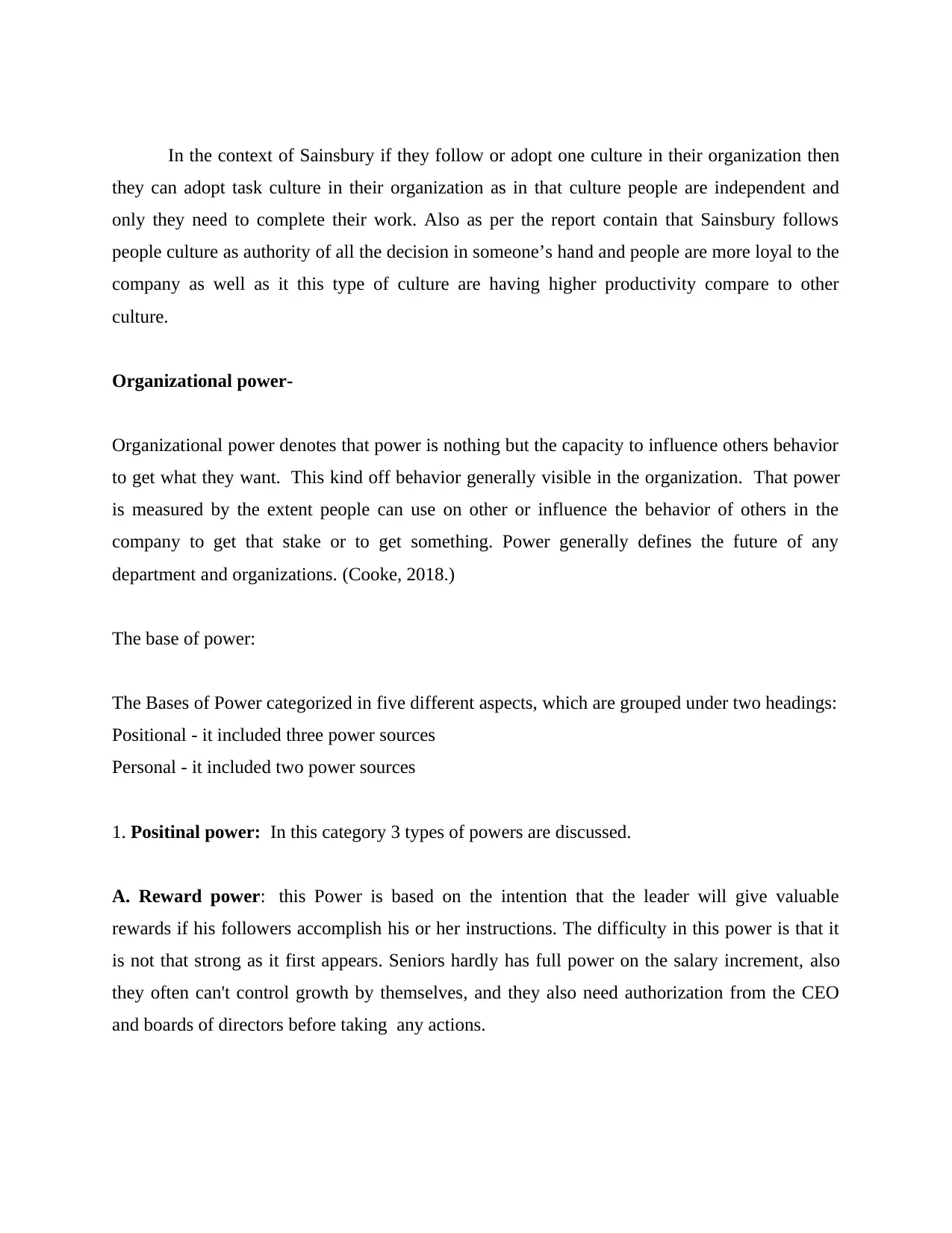
In the context of Sainsbury if they follow or adopt one culture in their organization then
they can adopt task culture in their organization as in that culture people are independent and
only they need to complete their work. Also as per the report contain that Sainsbury follows
people culture as authority of all the decision in someone’s hand and people are more loyal to the
company as well as it this type of culture are having higher productivity compare to other
culture.
Organizational power-
Organizational power denotes that power is nothing but the capacity to influence others behavior
to get what they want. This kind off behavior generally visible in the organization. That power
is measured by the extent people can use on other or influence the behavior of others in the
company to get that stake or to get something. Power generally defines the future of any
department and organizations. (Cooke, 2018.)
The base of power:
The Bases of Power categorized in five different aspects, which are grouped under two headings:
Positional - it included three power sources
Personal - it included two power sources
1. Positinal power: In this category 3 types of powers are discussed.
A. Reward power: this Power is based on the intention that the leader will give valuable
rewards if his followers accomplish his or her instructions. The difficulty in this power is that it
is not that strong as it first appears. Seniors hardly has full power on the salary increment, also
they often can't control growth by themselves, and they also need authorization from the CEO
and boards of directors before taking any actions.
they can adopt task culture in their organization as in that culture people are independent and
only they need to complete their work. Also as per the report contain that Sainsbury follows
people culture as authority of all the decision in someone’s hand and people are more loyal to the
company as well as it this type of culture are having higher productivity compare to other
culture.
Organizational power-
Organizational power denotes that power is nothing but the capacity to influence others behavior
to get what they want. This kind off behavior generally visible in the organization. That power
is measured by the extent people can use on other or influence the behavior of others in the
company to get that stake or to get something. Power generally defines the future of any
department and organizations. (Cooke, 2018.)
The base of power:
The Bases of Power categorized in five different aspects, which are grouped under two headings:
Positional - it included three power sources
Personal - it included two power sources
1. Positinal power: In this category 3 types of powers are discussed.
A. Reward power: this Power is based on the intention that the leader will give valuable
rewards if his followers accomplish his or her instructions. The difficulty in this power is that it
is not that strong as it first appears. Seniors hardly has full power on the salary increment, also
they often can't control growth by themselves, and they also need authorization from the CEO
and boards of directors before taking any actions.
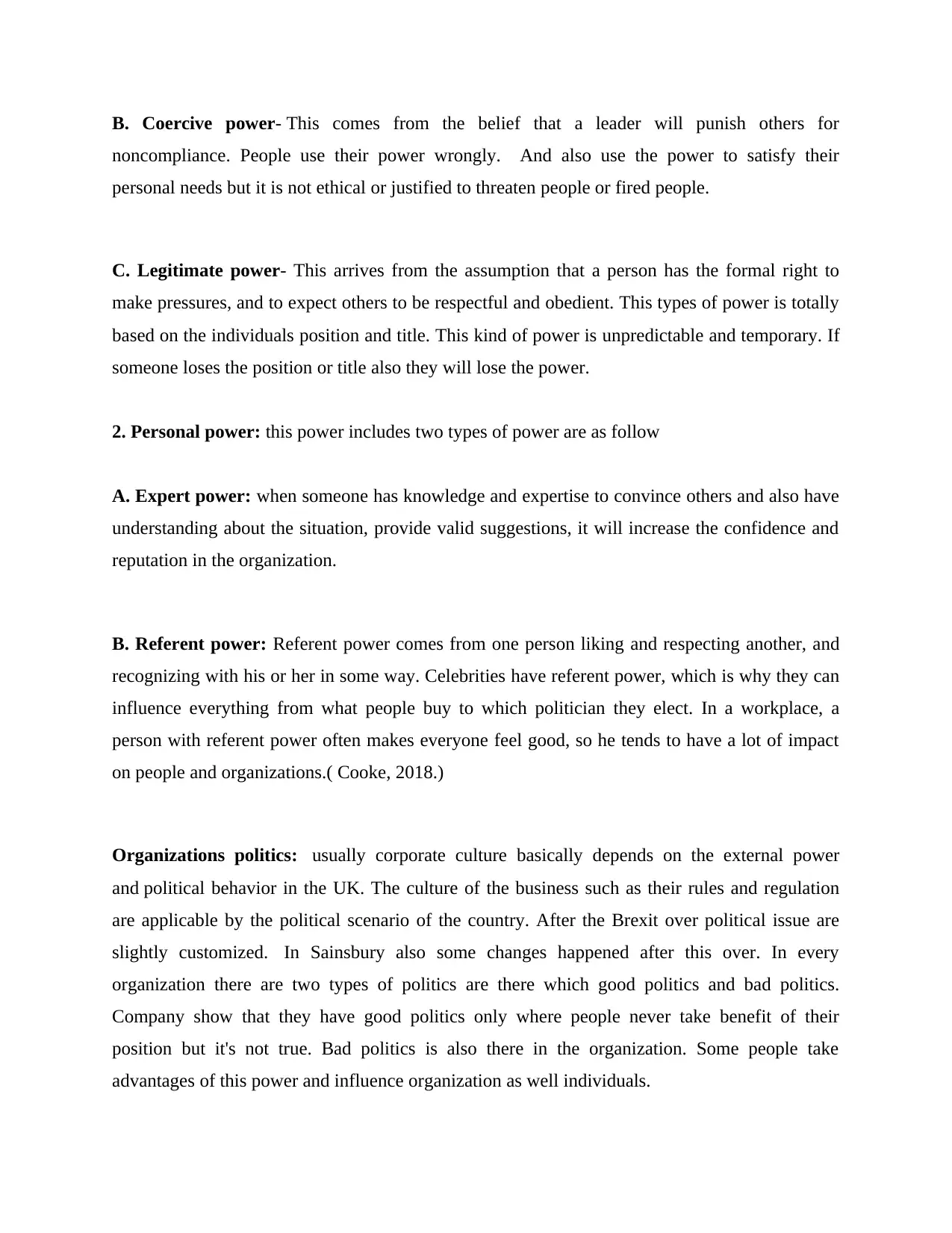
B. Coercive power- This comes from the belief that a leader will punish others for
noncompliance. People use their power wrongly. And also use the power to satisfy their
personal needs but it is not ethical or justified to threaten people or fired people.
C. Legitimate power- This arrives from the assumption that a person has the formal right to
make pressures, and to expect others to be respectful and obedient. This types of power is totally
based on the individuals position and title. This kind of power is unpredictable and temporary. If
someone loses the position or title also they will lose the power.
2. Personal power: this power includes two types of power are as follow
A. Expert power: when someone has knowledge and expertise to convince others and also have
understanding about the situation, provide valid suggestions, it will increase the confidence and
reputation in the organization.
B. Referent power: Referent power comes from one person liking and respecting another, and
recognizing with his or her in some way. Celebrities have referent power, which is why they can
influence everything from what people buy to which politician they elect. In a workplace, a
person with referent power often makes everyone feel good, so he tends to have a lot of impact
on people and organizations.( Cooke, 2018.)
Organizations politics: usually corporate culture basically depends on the external power
and political behavior in the UK. The culture of the business such as their rules and regulation
are applicable by the political scenario of the country. After the Brexit over political issue are
slightly customized. In Sainsbury also some changes happened after this over. In every
organization there are two types of politics are there which good politics and bad politics.
Company show that they have good politics only where people never take benefit of their
position but it's not true. Bad politics is also there in the organization. Some people take
advantages of this power and influence organization as well individuals.
noncompliance. People use their power wrongly. And also use the power to satisfy their
personal needs but it is not ethical or justified to threaten people or fired people.
C. Legitimate power- This arrives from the assumption that a person has the formal right to
make pressures, and to expect others to be respectful and obedient. This types of power is totally
based on the individuals position and title. This kind of power is unpredictable and temporary. If
someone loses the position or title also they will lose the power.
2. Personal power: this power includes two types of power are as follow
A. Expert power: when someone has knowledge and expertise to convince others and also have
understanding about the situation, provide valid suggestions, it will increase the confidence and
reputation in the organization.
B. Referent power: Referent power comes from one person liking and respecting another, and
recognizing with his or her in some way. Celebrities have referent power, which is why they can
influence everything from what people buy to which politician they elect. In a workplace, a
person with referent power often makes everyone feel good, so he tends to have a lot of impact
on people and organizations.( Cooke, 2018.)
Organizations politics: usually corporate culture basically depends on the external power
and political behavior in the UK. The culture of the business such as their rules and regulation
are applicable by the political scenario of the country. After the Brexit over political issue are
slightly customized. In Sainsbury also some changes happened after this over. In every
organization there are two types of politics are there which good politics and bad politics.
Company show that they have good politics only where people never take benefit of their
position but it's not true. Bad politics is also there in the organization. Some people take
advantages of this power and influence organization as well individuals.
⊘ This is a preview!⊘
Do you want full access?
Subscribe today to unlock all pages.

Trusted by 1+ million students worldwide
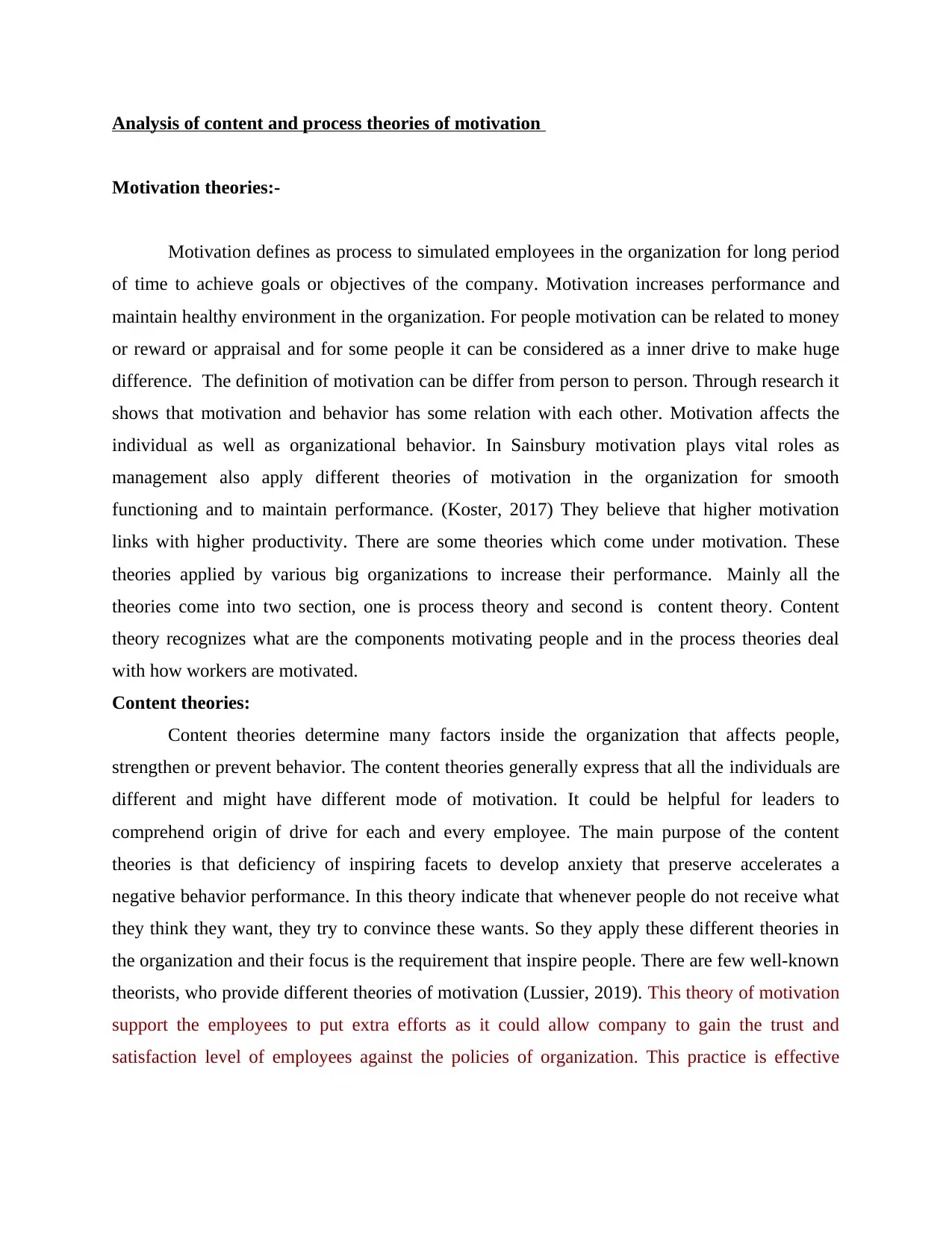
Analysis of content and process theories of motivation
Motivation theories:-
Motivation defines as process to simulated employees in the organization for long period
of time to achieve goals or objectives of the company. Motivation increases performance and
maintain healthy environment in the organization. For people motivation can be related to money
or reward or appraisal and for some people it can be considered as a inner drive to make huge
difference. The definition of motivation can be differ from person to person. Through research it
shows that motivation and behavior has some relation with each other. Motivation affects the
individual as well as organizational behavior. In Sainsbury motivation plays vital roles as
management also apply different theories of motivation in the organization for smooth
functioning and to maintain performance. (Koster, 2017) They believe that higher motivation
links with higher productivity. There are some theories which come under motivation. These
theories applied by various big organizations to increase their performance. Mainly all the
theories come into two section, one is process theory and second is content theory. Content
theory recognizes what are the components motivating people and in the process theories deal
with how workers are motivated.
Content theories:
Content theories determine many factors inside the organization that affects people,
strengthen or prevent behavior. The content theories generally express that all the individuals are
different and might have different mode of motivation. It could be helpful for leaders to
comprehend origin of drive for each and every employee. The main purpose of the content
theories is that deficiency of inspiring facets to develop anxiety that preserve accelerates a
negative behavior performance. In this theory indicate that whenever people do not receive what
they think they want, they try to convince these wants. So they apply these different theories in
the organization and their focus is the requirement that inspire people. There are few well-known
theorists, who provide different theories of motivation (Lussier, 2019). This theory of motivation
support the employees to put extra efforts as it could allow company to gain the trust and
satisfaction level of employees against the policies of organization. This practice is effective
Motivation theories:-
Motivation defines as process to simulated employees in the organization for long period
of time to achieve goals or objectives of the company. Motivation increases performance and
maintain healthy environment in the organization. For people motivation can be related to money
or reward or appraisal and for some people it can be considered as a inner drive to make huge
difference. The definition of motivation can be differ from person to person. Through research it
shows that motivation and behavior has some relation with each other. Motivation affects the
individual as well as organizational behavior. In Sainsbury motivation plays vital roles as
management also apply different theories of motivation in the organization for smooth
functioning and to maintain performance. (Koster, 2017) They believe that higher motivation
links with higher productivity. There are some theories which come under motivation. These
theories applied by various big organizations to increase their performance. Mainly all the
theories come into two section, one is process theory and second is content theory. Content
theory recognizes what are the components motivating people and in the process theories deal
with how workers are motivated.
Content theories:
Content theories determine many factors inside the organization that affects people,
strengthen or prevent behavior. The content theories generally express that all the individuals are
different and might have different mode of motivation. It could be helpful for leaders to
comprehend origin of drive for each and every employee. The main purpose of the content
theories is that deficiency of inspiring facets to develop anxiety that preserve accelerates a
negative behavior performance. In this theory indicate that whenever people do not receive what
they think they want, they try to convince these wants. So they apply these different theories in
the organization and their focus is the requirement that inspire people. There are few well-known
theorists, who provide different theories of motivation (Lussier, 2019). This theory of motivation
support the employees to put extra efforts as it could allow company to gain the trust and
satisfaction level of employees against the policies of organization. This practice is effective
Paraphrase This Document
Need a fresh take? Get an instant paraphrase of this document with our AI Paraphraser
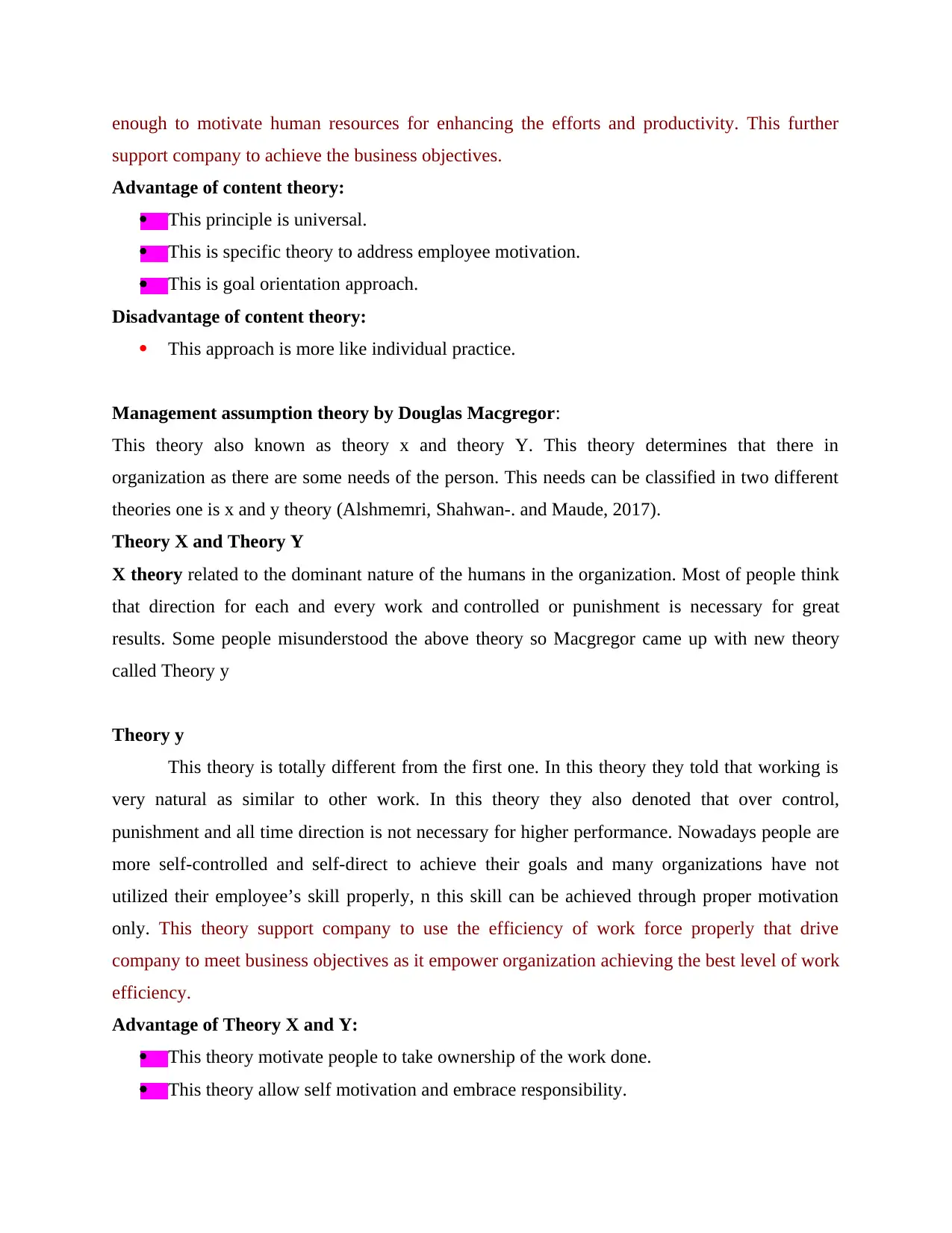
enough to motivate human resources for enhancing the efforts and productivity. This further
support company to achieve the business objectives.
Advantage of content theory:
This principle is universal.
This is specific theory to address employee motivation.
This is goal orientation approach.
Disadvantage of content theory:
This approach is more like individual practice.
Management assumption theory by Douglas Macgregor:
This theory also known as theory x and theory Y. This theory determines that there in
organization as there are some needs of the person. This needs can be classified in two different
theories one is x and y theory (Alshmemri, Shahwan-. and Maude, 2017).
Theory X and Theory Y
X theory related to the dominant nature of the humans in the organization. Most of people think
that direction for each and every work and controlled or punishment is necessary for great
results. Some people misunderstood the above theory so Macgregor came up with new theory
called Theory y
Theory y
This theory is totally different from the first one. In this theory they told that working is
very natural as similar to other work. In this theory they also denoted that over control,
punishment and all time direction is not necessary for higher performance. Nowadays people are
more self-controlled and self-direct to achieve their goals and many organizations have not
utilized their employee’s skill properly, n this skill can be achieved through proper motivation
only. This theory support company to use the efficiency of work force properly that drive
company to meet business objectives as it empower organization achieving the best level of work
efficiency.
Advantage of Theory X and Y:
This theory motivate people to take ownership of the work done.
This theory allow self motivation and embrace responsibility.
support company to achieve the business objectives.
Advantage of content theory:
This principle is universal.
This is specific theory to address employee motivation.
This is goal orientation approach.
Disadvantage of content theory:
This approach is more like individual practice.
Management assumption theory by Douglas Macgregor:
This theory also known as theory x and theory Y. This theory determines that there in
organization as there are some needs of the person. This needs can be classified in two different
theories one is x and y theory (Alshmemri, Shahwan-. and Maude, 2017).
Theory X and Theory Y
X theory related to the dominant nature of the humans in the organization. Most of people think
that direction for each and every work and controlled or punishment is necessary for great
results. Some people misunderstood the above theory so Macgregor came up with new theory
called Theory y
Theory y
This theory is totally different from the first one. In this theory they told that working is
very natural as similar to other work. In this theory they also denoted that over control,
punishment and all time direction is not necessary for higher performance. Nowadays people are
more self-controlled and self-direct to achieve their goals and many organizations have not
utilized their employee’s skill properly, n this skill can be achieved through proper motivation
only. This theory support company to use the efficiency of work force properly that drive
company to meet business objectives as it empower organization achieving the best level of work
efficiency.
Advantage of Theory X and Y:
This theory motivate people to take ownership of the work done.
This theory allow self motivation and embrace responsibility.
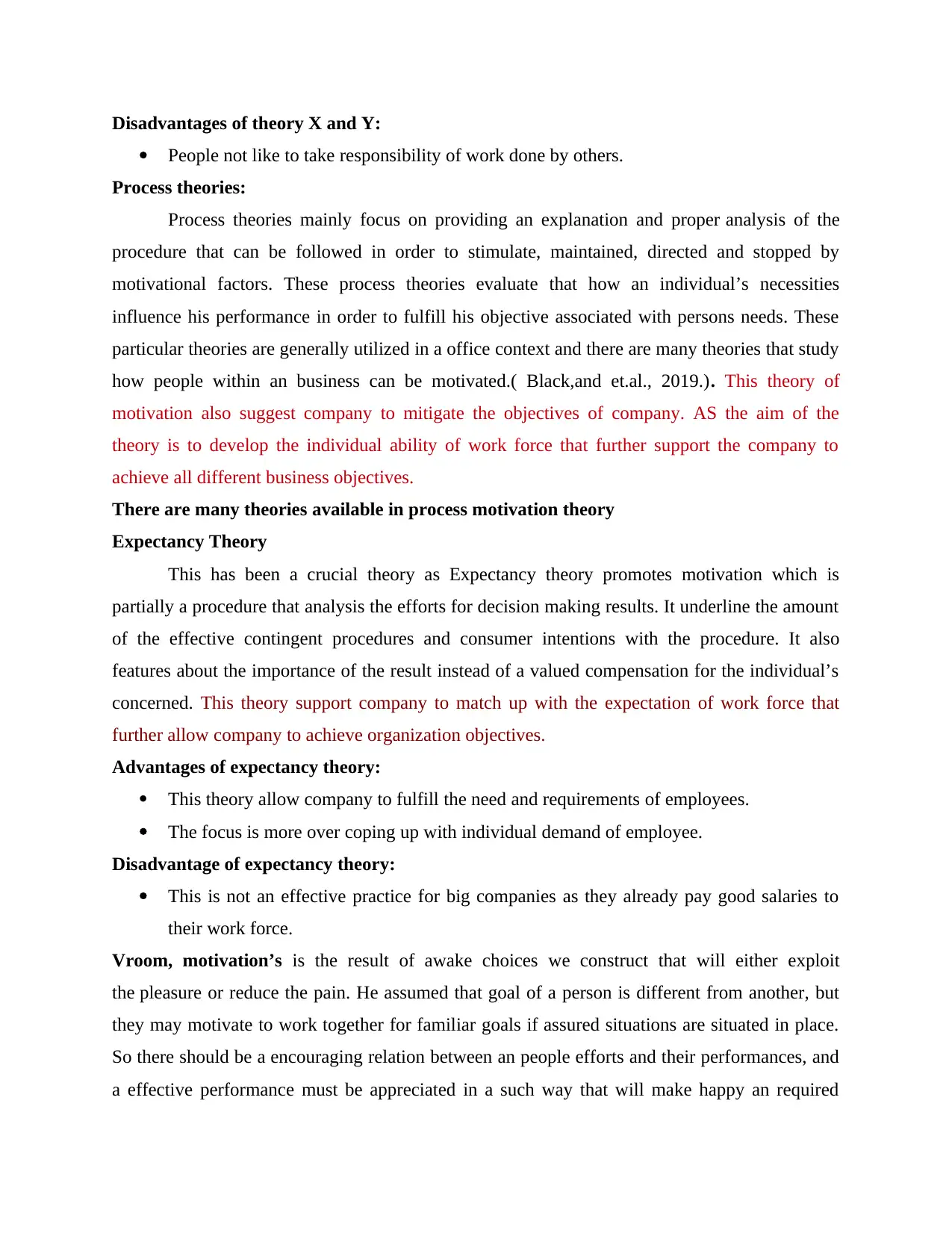
Disadvantages of theory X and Y:
People not like to take responsibility of work done by others.
Process theories:
Process theories mainly focus on providing an explanation and proper analysis of the
procedure that can be followed in order to stimulate, maintained, directed and stopped by
motivational factors. These process theories evaluate that how an individual’s necessities
influence his performance in order to fulfill his objective associated with persons needs. These
particular theories are generally utilized in a office context and there are many theories that study
how people within an business can be motivated.( Black,and et.al., 2019.). This theory of
motivation also suggest company to mitigate the objectives of company. AS the aim of the
theory is to develop the individual ability of work force that further support the company to
achieve all different business objectives.
There are many theories available in process motivation theory
Expectancy Theory
This has been a crucial theory as Expectancy theory promotes motivation which is
partially a procedure that analysis the efforts for decision making results. It underline the amount
of the effective contingent procedures and consumer intentions with the procedure. It also
features about the importance of the result instead of a valued compensation for the individual’s
concerned. This theory support company to match up with the expectation of work force that
further allow company to achieve organization objectives.
Advantages of expectancy theory:
This theory allow company to fulfill the need and requirements of employees.
The focus is more over coping up with individual demand of employee.
Disadvantage of expectancy theory:
This is not an effective practice for big companies as they already pay good salaries to
their work force.
Vroom, motivation’s is the result of awake choices we construct that will either exploit
the pleasure or reduce the pain. He assumed that goal of a person is different from another, but
they may motivate to work together for familiar goals if assured situations are situated in place.
So there should be a encouraging relation between an people efforts and their performances, and
a effective performance must be appreciated in a such way that will make happy an required
People not like to take responsibility of work done by others.
Process theories:
Process theories mainly focus on providing an explanation and proper analysis of the
procedure that can be followed in order to stimulate, maintained, directed and stopped by
motivational factors. These process theories evaluate that how an individual’s necessities
influence his performance in order to fulfill his objective associated with persons needs. These
particular theories are generally utilized in a office context and there are many theories that study
how people within an business can be motivated.( Black,and et.al., 2019.). This theory of
motivation also suggest company to mitigate the objectives of company. AS the aim of the
theory is to develop the individual ability of work force that further support the company to
achieve all different business objectives.
There are many theories available in process motivation theory
Expectancy Theory
This has been a crucial theory as Expectancy theory promotes motivation which is
partially a procedure that analysis the efforts for decision making results. It underline the amount
of the effective contingent procedures and consumer intentions with the procedure. It also
features about the importance of the result instead of a valued compensation for the individual’s
concerned. This theory support company to match up with the expectation of work force that
further allow company to achieve organization objectives.
Advantages of expectancy theory:
This theory allow company to fulfill the need and requirements of employees.
The focus is more over coping up with individual demand of employee.
Disadvantage of expectancy theory:
This is not an effective practice for big companies as they already pay good salaries to
their work force.
Vroom, motivation’s is the result of awake choices we construct that will either exploit
the pleasure or reduce the pain. He assumed that goal of a person is different from another, but
they may motivate to work together for familiar goals if assured situations are situated in place.
So there should be a encouraging relation between an people efforts and their performances, and
a effective performance must be appreciated in a such way that will make happy an required
⊘ This is a preview!⊘
Do you want full access?
Subscribe today to unlock all pages.

Trusted by 1+ million students worldwide
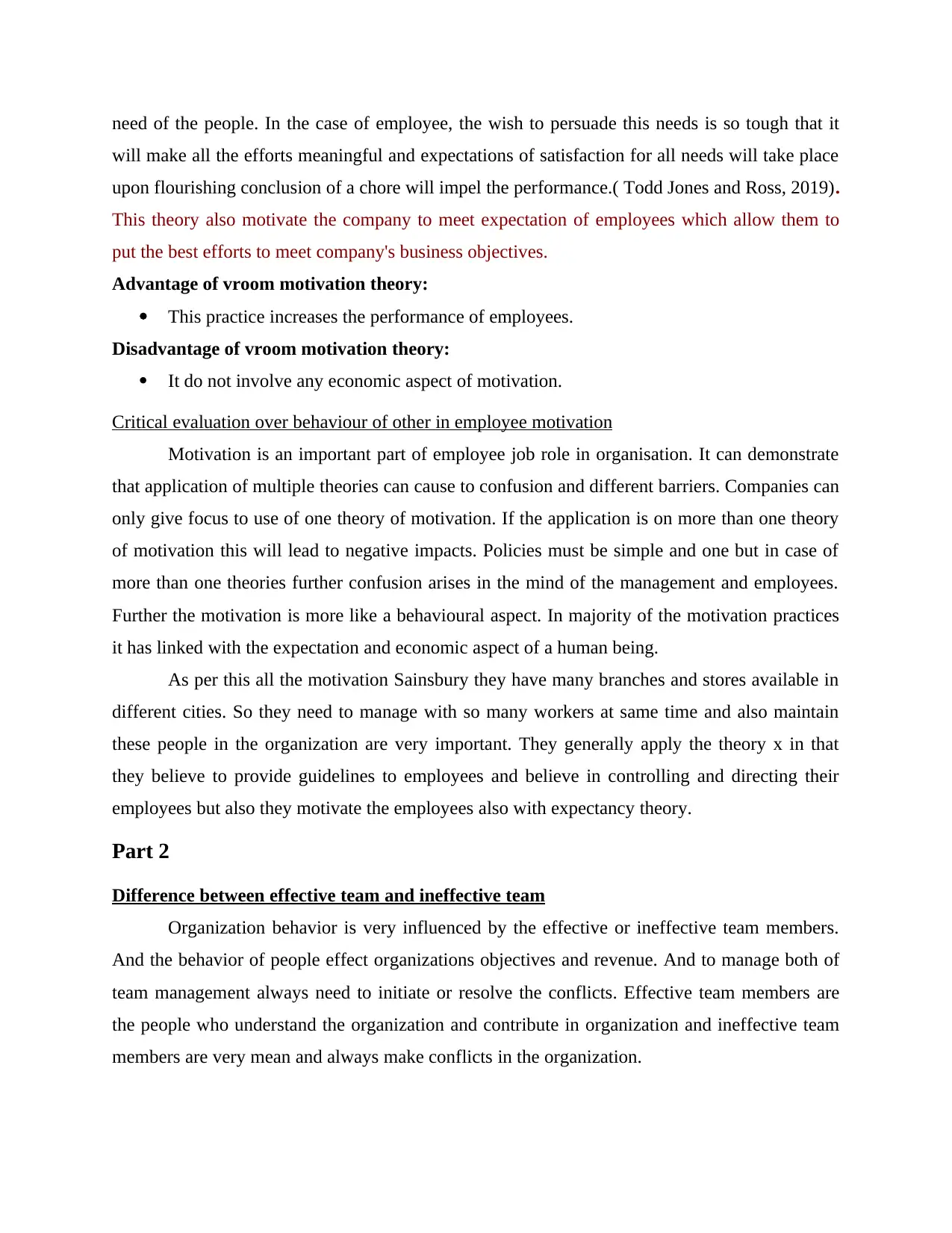
need of the people. In the case of employee, the wish to persuade this needs is so tough that it
will make all the efforts meaningful and expectations of satisfaction for all needs will take place
upon flourishing conclusion of a chore will impel the performance.( Todd Jones and Ross, 2019).
This theory also motivate the company to meet expectation of employees which allow them to
put the best efforts to meet company's business objectives.
Advantage of vroom motivation theory:
This practice increases the performance of employees.
Disadvantage of vroom motivation theory:
It do not involve any economic aspect of motivation.
Critical evaluation over behaviour of other in employee motivation
Motivation is an important part of employee job role in organisation. It can demonstrate
that application of multiple theories can cause to confusion and different barriers. Companies can
only give focus to use of one theory of motivation. If the application is on more than one theory
of motivation this will lead to negative impacts. Policies must be simple and one but in case of
more than one theories further confusion arises in the mind of the management and employees.
Further the motivation is more like a behavioural aspect. In majority of the motivation practices
it has linked with the expectation and economic aspect of a human being.
As per this all the motivation Sainsbury they have many branches and stores available in
different cities. So they need to manage with so many workers at same time and also maintain
these people in the organization are very important. They generally apply the theory x in that
they believe to provide guidelines to employees and believe in controlling and directing their
employees but also they motivate the employees also with expectancy theory.
Part 2
Difference between effective team and ineffective team
Organization behavior is very influenced by the effective or ineffective team members.
And the behavior of people effect organizations objectives and revenue. And to manage both of
team management always need to initiate or resolve the conflicts. Effective team members are
the people who understand the organization and contribute in organization and ineffective team
members are very mean and always make conflicts in the organization.
will make all the efforts meaningful and expectations of satisfaction for all needs will take place
upon flourishing conclusion of a chore will impel the performance.( Todd Jones and Ross, 2019).
This theory also motivate the company to meet expectation of employees which allow them to
put the best efforts to meet company's business objectives.
Advantage of vroom motivation theory:
This practice increases the performance of employees.
Disadvantage of vroom motivation theory:
It do not involve any economic aspect of motivation.
Critical evaluation over behaviour of other in employee motivation
Motivation is an important part of employee job role in organisation. It can demonstrate
that application of multiple theories can cause to confusion and different barriers. Companies can
only give focus to use of one theory of motivation. If the application is on more than one theory
of motivation this will lead to negative impacts. Policies must be simple and one but in case of
more than one theories further confusion arises in the mind of the management and employees.
Further the motivation is more like a behavioural aspect. In majority of the motivation practices
it has linked with the expectation and economic aspect of a human being.
As per this all the motivation Sainsbury they have many branches and stores available in
different cities. So they need to manage with so many workers at same time and also maintain
these people in the organization are very important. They generally apply the theory x in that
they believe to provide guidelines to employees and believe in controlling and directing their
employees but also they motivate the employees also with expectancy theory.
Part 2
Difference between effective team and ineffective team
Organization behavior is very influenced by the effective or ineffective team members.
And the behavior of people effect organizations objectives and revenue. And to manage both of
team management always need to initiate or resolve the conflicts. Effective team members are
the people who understand the organization and contribute in organization and ineffective team
members are very mean and always make conflicts in the organization.
Paraphrase This Document
Need a fresh take? Get an instant paraphrase of this document with our AI Paraphraser
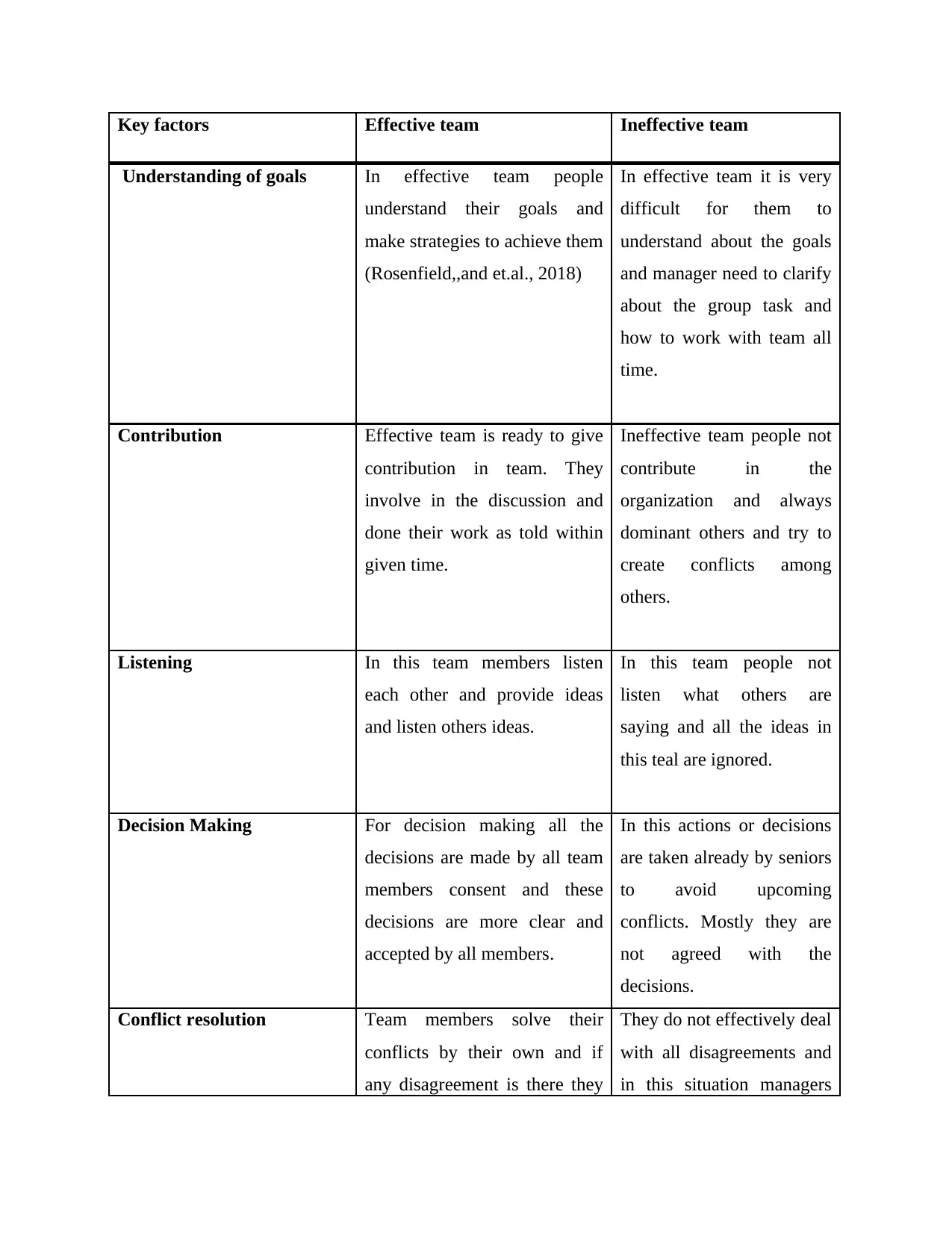
Key factors Effective team Ineffective team
Understanding of goals In effective team people
understand their goals and
make strategies to achieve them
(Rosenfield,,and et.al., 2018)
In effective team it is very
difficult for them to
understand about the goals
and manager need to clarify
about the group task and
how to work with team all
time.
Contribution Effective team is ready to give
contribution in team. They
involve in the discussion and
done their work as told within
given time.
Ineffective team people not
contribute in the
organization and always
dominant others and try to
create conflicts among
others.
Listening In this team members listen
each other and provide ideas
and listen others ideas.
In this team people not
listen what others are
saying and all the ideas in
this teal are ignored.
Decision Making For decision making all the
decisions are made by all team
members consent and these
decisions are more clear and
accepted by all members.
In this actions or decisions
are taken already by seniors
to avoid upcoming
conflicts. Mostly they are
not agreed with the
decisions.
Conflict resolution Team members solve their
conflicts by their own and if
any disagreement is there they
They do not effectively deal
with all disagreements and
in this situation managers
Understanding of goals In effective team people
understand their goals and
make strategies to achieve them
(Rosenfield,,and et.al., 2018)
In effective team it is very
difficult for them to
understand about the goals
and manager need to clarify
about the group task and
how to work with team all
time.
Contribution Effective team is ready to give
contribution in team. They
involve in the discussion and
done their work as told within
given time.
Ineffective team people not
contribute in the
organization and always
dominant others and try to
create conflicts among
others.
Listening In this team members listen
each other and provide ideas
and listen others ideas.
In this team people not
listen what others are
saying and all the ideas in
this teal are ignored.
Decision Making For decision making all the
decisions are made by all team
members consent and these
decisions are more clear and
accepted by all members.
In this actions or decisions
are taken already by seniors
to avoid upcoming
conflicts. Mostly they are
not agreed with the
decisions.
Conflict resolution Team members solve their
conflicts by their own and if
any disagreement is there they
They do not effectively deal
with all disagreements and
in this situation managers
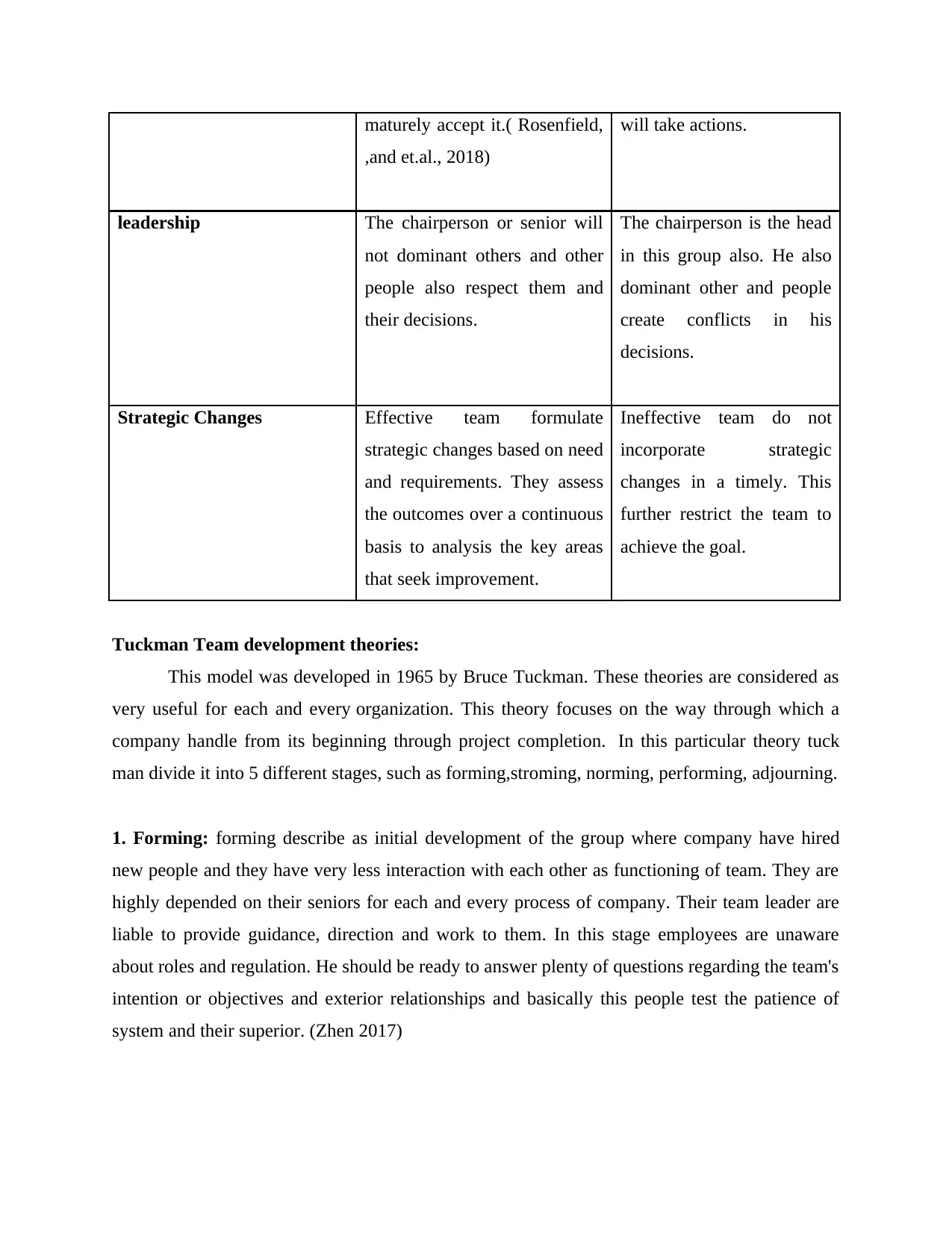
maturely accept it.( Rosenfield,
,and et.al., 2018)
will take actions.
leadership The chairperson or senior will
not dominant others and other
people also respect them and
their decisions.
The chairperson is the head
in this group also. He also
dominant other and people
create conflicts in his
decisions.
Strategic Changes Effective team formulate
strategic changes based on need
and requirements. They assess
the outcomes over a continuous
basis to analysis the key areas
that seek improvement.
Ineffective team do not
incorporate strategic
changes in a timely. This
further restrict the team to
achieve the goal.
Tuckman Team development theories:
This model was developed in 1965 by Bruce Tuckman. These theories are considered as
very useful for each and every organization. This theory focuses on the way through which a
company handle from its beginning through project completion. In this particular theory tuck
man divide it into 5 different stages, such as forming,stroming, norming, performing, adjourning.
1. Forming: forming describe as initial development of the group where company have hired
new people and they have very less interaction with each other as functioning of team. They are
highly depended on their seniors for each and every process of company. Their team leader are
liable to provide guidance, direction and work to them. In this stage employees are unaware
about roles and regulation. He should be ready to answer plenty of questions regarding the team's
intention or objectives and exterior relationships and basically this people test the patience of
system and their superior. (Zhen 2017)
,and et.al., 2018)
will take actions.
leadership The chairperson or senior will
not dominant others and other
people also respect them and
their decisions.
The chairperson is the head
in this group also. He also
dominant other and people
create conflicts in his
decisions.
Strategic Changes Effective team formulate
strategic changes based on need
and requirements. They assess
the outcomes over a continuous
basis to analysis the key areas
that seek improvement.
Ineffective team do not
incorporate strategic
changes in a timely. This
further restrict the team to
achieve the goal.
Tuckman Team development theories:
This model was developed in 1965 by Bruce Tuckman. These theories are considered as
very useful for each and every organization. This theory focuses on the way through which a
company handle from its beginning through project completion. In this particular theory tuck
man divide it into 5 different stages, such as forming,stroming, norming, performing, adjourning.
1. Forming: forming describe as initial development of the group where company have hired
new people and they have very less interaction with each other as functioning of team. They are
highly depended on their seniors for each and every process of company. Their team leader are
liable to provide guidance, direction and work to them. In this stage employees are unaware
about roles and regulation. He should be ready to answer plenty of questions regarding the team's
intention or objectives and exterior relationships and basically this people test the patience of
system and their superior. (Zhen 2017)
⊘ This is a preview!⊘
Do you want full access?
Subscribe today to unlock all pages.

Trusted by 1+ million students worldwide
1 out of 18
Related Documents
Your All-in-One AI-Powered Toolkit for Academic Success.
+13062052269
info@desklib.com
Available 24*7 on WhatsApp / Email
![[object Object]](/_next/static/media/star-bottom.7253800d.svg)
Unlock your academic potential
Copyright © 2020–2025 A2Z Services. All Rights Reserved. Developed and managed by ZUCOL.



